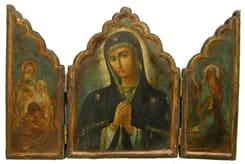Triptych Featuring the Virgin, 19th Century CE
Oil on Wood Panels
11
PF.5981
Further images
Russians inherited the tradition of icon painting from Byzantium, where it began as an offshoot of the mosaic and fresco tradition. During the 8th and 9th centuries, the iconoclastic controversy...
Russians inherited the tradition of icon painting from Byzantium, where it began as an offshoot of the mosaic and fresco tradition. During the 8th and 9th centuries, the iconoclastic controversy in the Orthodox Church called into question whether religious images were a legitimate practice or sacrilegious idolatry. Although the use of images was in the end permitted, a thorough distinction between profane art intended to depict reality and sacred art designed for spiritual contemplation was established. Certain kinds of balance and harmony became established as reflections of divinity, and as such they invited careful reproduction and subtle refinement rather than striking novelty. Although this philosophy resulted in a comparatively slow evolution of style, icon painting evolved considerably over the centuries. Unlike the pictorial traditions of the west that aspire towards increased realism and naturalism, the essence of Russian icon painting is not about the representation of physical space or appearance. Icons are images intended to aid in contemplative prayer, and in that sense, are more concerned with conveying meditative harmony than with laying out a realistic scene.
When the side panels of this triptych are closed, the wonders of the interior are concealed. Unlocked and opened, the glorious image of the Virgin Mary is revealed. A gentle light emanates from around her head, defining her divine nature. The side panels depict scenes of saints aiding the elderly and poor. On the left, an unidentified saint, possibly Zachary, covers an old man with a robe. The old man reverently looks toward the Virgin as he comforts a young man who appears to be ill, holding his hand to his chest. On the right wing, St. Mark guides the gaze of a youthful follower to the central image of Mary. The side panels, when folded, serve to protect the painting for travel while when open they reiterate and reinforce the dominant depiction of Mary. Naturally, the Virgin stares out at us, the viewer. She draws us into the work, and captures our attention. In case our eyes wonder, the scenes in the wings return our focus to their Virgin through the figures’ adoration. Thus as the sick and elderly turn to Mary for guidance and salvation, so do we.
When the side panels of this triptych are closed, the wonders of the interior are concealed. Unlocked and opened, the glorious image of the Virgin Mary is revealed. A gentle light emanates from around her head, defining her divine nature. The side panels depict scenes of saints aiding the elderly and poor. On the left, an unidentified saint, possibly Zachary, covers an old man with a robe. The old man reverently looks toward the Virgin as he comforts a young man who appears to be ill, holding his hand to his chest. On the right wing, St. Mark guides the gaze of a youthful follower to the central image of Mary. The side panels, when folded, serve to protect the painting for travel while when open they reiterate and reinforce the dominant depiction of Mary. Naturally, the Virgin stares out at us, the viewer. She draws us into the work, and captures our attention. In case our eyes wonder, the scenes in the wings return our focus to their Virgin through the figures’ adoration. Thus as the sick and elderly turn to Mary for guidance and salvation, so do we.











